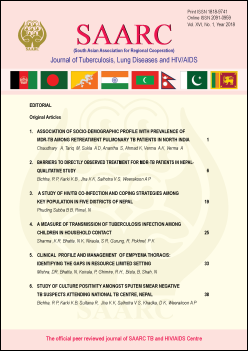Clinical Profile and Management of Empyema Thoracis: Experience from Eastern Nepal
DOI:
https://doi.org/10.3126/saarctb.v16i1.23242Keywords:
Empyema Thoracis, Clinical Profile, ReferralAbstract
Introduction: The management of Empyema Thoracis is challenging. It requires specialist medical and surgical care at the same time. There are of lack of data regarding the clinical profile and the steps of day to day management, hence this study aims to identify these parameters and focus on the gaps in management that is commonplace in our setting and that are representative of other resource limited settings as well.
Methods: Clinical profile, etiological agents, hospital course and outcome of 30 patients with empyema thoracis treated from 2012 to 2014 in B.P. Koirala Institute of Health Sciences was analyzed. All patients were diagnosed on the basis of aspiration of frank pus from pleural cavity.
Results: 28 cases (93.3%) were Male and the mean age was 42.07±18.28 years. 73.3% of the empyema was Right sided and 60% were classified as medium sized and 40% as small sized. 60% of the patients were smokers. 80% of the case were diagnosed as bacterial infection whereas 20% were presumed tubercular on clinical basis and responded to treatment. Fever was the commonest presentation in 80% of the cases followed by shortness of breath (66.7%), cough (60%), chest pain (53.3%) and sputum production (20%). On investigation, pH was not measured in the fear of clogging the ABG machine. Pleural fluid glucose was below 40 mg/dl in all the cases. The median ADA value was 54.30 (15-350) and ADA was higher than 40 U/l in 10 cases with non-tubercular empyema. All cases were managed with Chest tube insertion and antibiotics. Four patients had to be referred for BPF closure whereas five for decortications. In all cases requiring decortications, a “pleural peel” could be identified in Chest Xrays. Since the patients were being managed in different units the outcome of referred patients could not be ascertained.
Conclusion: The gaps in the management of empyema in resource limited setting starts from inappropriate early treatment, inadequate diagnostic facilities, delayed referral and lack of early and appropriate surgical intervention. All these factors combine to the increased morbidity and mortality associated with the management of Empyema thoracis.
Downloads
Downloads
Published
How to Cite
Issue
Section
License
Copyright © SAARC Tuberculosis and HIV/AIDS Centre (STAC), all rights reserved, no part of this publication may be reproduced, stored in a retrieval system or transmitted in any form or by any means without prior permission of the STAC.





